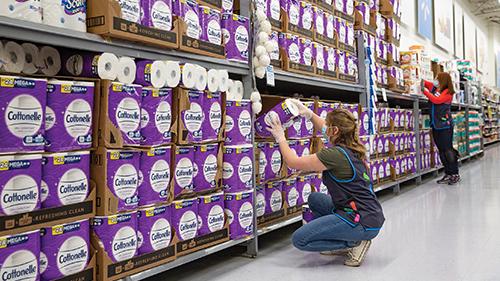“COVID-19 really raised the importance of the supply chain,” observes Tom Madrecki, VP of supply chain for the Consumer Brands Association (CBA), also based in Arlington. “It went from being an issue that was maybe not front and center within the c-suite or within government to being the issue of the moment.”
Ultimately, the chain didn’t break, but some vulnerabilities were revealed — and exposed to consumers — as excess agricultural products ended up being destroyed, certain products became obsolete seemingly overnight and e-commerce programs were suddenly being used more than ever before, revealing a gap in different retailers’ levels of preparedness.
Now that the pandemic’s initial outbreak has passed, the industry has a brief window of time to reflect on what worked, what went wrong, and ultimately how to plan ahead for what’s next.
“I’m hoping retailers have either built or updated their ‘disruption playbooks’ to understand what they need to do going forward,” says Mike Griswold, a research VP with the consumer value chain team at Gartner, a global research and advisory firm based in Stamford, Conn. “A lot of them probably had some type of disruption playbook, but nothing of the magnitude to where they’d need to be limiting products and customer counts, and forcing the majority of people to do an online transaction. This is certainly the biggest disruption most of us have experienced in retail — and it’s not going to be the last.”
At presstime, the term “second wave” is being floated as several states are seeing worrisome spikes in cases and hospitalization rates. Some experts caution that autumn could be particularly bad, as seasonal flu begins cropping up alongside the novel coronavirus. While no one can predict the future precisely, one thing’s for certain: Retailers need to be prepared as much as possible and focused on building a more resilient supply chain to adapt to whatever comes their way.
Here are key areas that they can focus on to make their supply chains as COVID-proof as possible, according to Griswold and other industry watchers:
- Build in more agility and flexibility;
- Increase the frequency of supply chain modeling;
- Work to more quickly adopt new technologies that can aid in visibility, planning and beyond;
- Better collaborate with suppliers and other industry partners, and rethink supplier diversification;
- Focus on a well-protected, more cross-functional and flexible labor force; and
- Reconsider the balance of in-store versus online sales, with a specific focus on last-mile delivery.
Walmart’s Focus on Agility
During a recent webinar entitled “COVID-19 Supply Chain Risk Management,” conducted by Eyefortransport Ltd. and Reuters Events, several leaders representing various areas of the grocery supply chain shared their thoughts on better preparing for unforeseen conflicts in the age of the coronavirus.
Josh Buchanan, director of supply chain design and innovation for Bentonville, Ark.-based Walmart, noted, “In our processes of refreshing supply chain strategies annually for our international partners, we’re going to see that leaders reviewing those strategies are going to have [COVID-19] as a lens for the near future. There will be a value on agility in contingency planning.”


